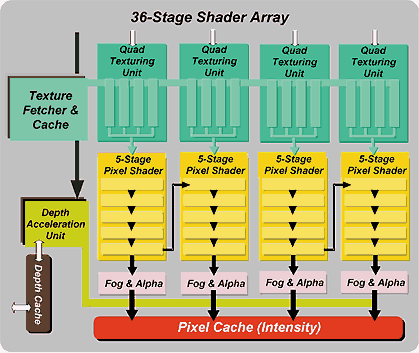Matrox Parhelia-512 - The Challenger
36-Stage Shader Array, Including 64 Super Sample Texture Filtering
The Parhelia-512 chip offers a lot of power with regard to pixel calculation as well. It has over four pixel pipelines, each of which contains over four texture units. This means that four textures per clock and per texel can be used (quad texturing).

NVIDIA's GeForce 3 and 4 series also has over four pipelines, but they only have two units each. Therefore, when it comes to multi-texturing, Parhelia is significantly faster than a GeForce 4 Ti, at least on paper.
Furthermore, each texture unit is connected to a 5-stage DirectX 8.1 pixel shader (v1.3). By comparison, GeForce 4 and Radeon 8500 have only two stages, so Matrox provides a total of 36 shader stages, as opposed to 16 from its competitors.

Through this extensive array, Parhelia also achieves a very good performance when anisotropic filtering is used, where up to 64 texture samples per clock are allocated to the texture units. Here, the loss in performance with texture filtering is significantly less than with the competitors.
With dual-texture pixels and anisotropic filtering, Matrox also promises performance levels similar to that of trilinear performance with the competitors.
Stay on the Cutting Edge
Join the experts who read Tom's Hardware for the inside track on enthusiast PC tech news — and have for over 25 years. We'll send breaking news and in-depth reviews of CPUs, GPUs, AI, maker hardware and more straight to your inbox.
Current page: 36-Stage Shader Array, Including 64 Super Sample Texture Filtering
Prev Page Hardware Displacement Mapping Next Page 16x Fragment Anti-AliasingMost Popular

